
Concept explainers
(a)
Interpretation: The product formed by the treatment of
Concept introduction: Monosaccharides are the small units of simple sugars. The hydroxyl groups of monosaccharides are converted into the ether groups in presence of base and
Answer to Problem 28.50P
The product formed by the treatment of
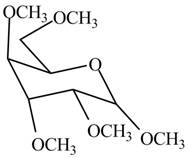
Explanation of Solution
The conversion of hydroxyl groups of

Figure 1
The product formed by the treatment of
(b)
Interpretation: The product formed by the treatment of
Concept introduction: Monosaccharides are the small units of simple sugars. The hydroxyl groups of monosaccharides are converted into the ether groups in presence of base and alkyl halide.
Answer to Problem 28.50P
The products formed by the treatment of

Explanation of Solution
The two anomers are formed by the treatment of monosaccharides with methanol in the presence of hydrochloric acid. One product with methoxy group on the equatorial position and other product with methoxy group on the axial position. The corresponding chemical reaction is shown below.

Figure 2
The products formed by the treatment of
(c)
Interpretation: The product formed by the treatment of
Concept introduction: Monosaccharides are the small units of simple sugars. The hydroxyl groups of monosaccharides are converted into the ether groups in presence of base and alkyl halide.
Answer to Problem 28.50P
The products formed by the treatment of
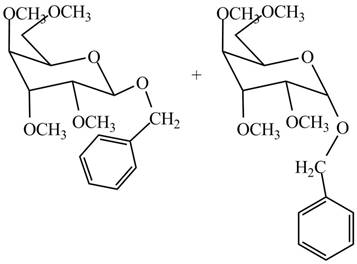
Explanation of Solution
The conversion of hydroxyl groups of product

Figure 3
The product formed by the treatment of
(d)
Interpretation: The product formed by the treatment of
Concept introduction: Monosaccharides are the small units of simple sugars. The hydroxyl groups of monosaccharides are converted into the ether groups in presence of base and alkyl halide.
Answer to Problem 28.50P
The products formed by the treatment of

Explanation of Solution
The first step is the conversion of hydroxyl groups of gulose into the ether groups in the presence of

Figure 4
The products formed by the treatment of
(e)
Interpretation: The product formed by the treatment of
Concept introduction: Monosaccharides are the small units of simple sugars. The hydroxyl groups of monosaccharides are converted into the ether groups in presence of base and alkyl halide.
Answer to Problem 28.50P
The product formed by the treatment of
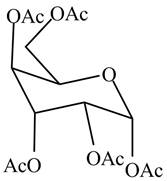
Explanation of Solution
In the presence of acetic anhydride and pyridine, the conversion of alcoholic groups in
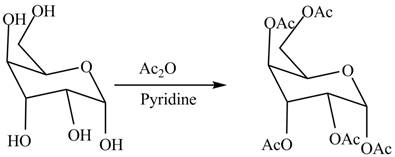
Figure 5
The products formed by the treatment of
(f)
Interpretation: The product formed by the treatment of
Concept introduction: Monosaccharides are the small units of simple sugars. The hydroxyl groups of monosaccharides are converted into the ether groups in presence of base and alkyl halide.
Answer to Problem 28.50P
The product formed by the treatment of

Explanation of Solution
In the presence of

Figure 7
The products formed by the treatment of
(g)
Interpretation: The product formed by the treatment of
Concept introduction: Monosaccharides are the small units of simple sugars. The hydroxyl groups of monosaccharides are converted into the ether groups in presence of base and alkyl halide.
Answer to Problem 28.50P
The products formed by the treatment of

Explanation of Solution
The first step is the conversion of hydroxyl groups of gulose into the ether groups in presence of base and methyl iodide as shown in Figure 2.
The product

Figure 8
The products formed by the treatment of
(h)
Interpretation: The product formed by the treatment of
Concept introduction: Monosaccharides are the small units of simple sugars The hydroxyl groups of monosaccharides are converted into the ester groups in presence of base and acetic anhydride or acetyl chloride.
Answer to Problem 28.50P
The products formed by the treatment of

Explanation of Solution
The conversion of alcoholic groups of product

Figure 9
The products formed by the treatment of
(i)
Interpretation: The product formed by the treatment of
Concept introduction: Monosaccharides are the small units of simple sugars The hydroxyl groups of monosaccharides are converted into the ester groups in presence of base and acetic anhydride or acetyl chloride.
Answer to Problem 28.50P
The products formed by the treatment of
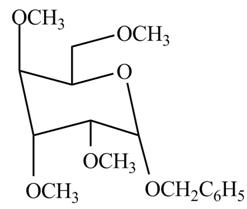
Explanation of Solution
The conversion of the product

Figure 10
The products formed by the treatment of
(j)
Interpretation: The product formed by the treatment of
Concept introduction: Monosaccharides are the small units of simple sugars The hydroxyl groups of monosaccharides are converted into the ester groups in presence of base and acetic anhydride or acetyl chloride.
Answer to Problem 28.50P
The products formed by the treatment of

Explanation of Solution
The conversion of the product

Figure 11
The products formed by the treatment of
Want to see more full solutions like this?
Chapter 28 Solutions
Organic Chemistry
- State the products (formulas) of the reaction of acetophenone with iodine and NaOH.arrow_forwardExplanation Check Draw the skeletal ("line") structure of 5-hydroxy-4-methyl-2-pentanone. Click and drag to start drawing a structure. Х © 2025 McGraw Hill LLC. All Rights Reserved. Terms of Use | Privacy Cer ☐ : Carrow_forward1. Using a Model set Build a model for the following compound [CH2BrCI]. 2. Build another model of the mirror image of your first molecule. 3. Place the two models next to each other and take a picture which shows the differences between the two models. 4. Determine the absolute stereochemistry R or S for the two models. 5. Write or type a paragraph to Discuss the stereochemical relationship between the two models of CH2BrCl. You must provide an explanation for your conclusions also provide a description for the colors used to represent each atom in the model's images.arrow_forward
- What parameters are included in the specific rotation calculation of a pure substance based on measurement from a polarimeter? Select one or more: Density of the sample Pathlength of the sample container Enantiomeric excess of the sample Measured rotation of lightarrow_forwardV Determine whether the following molecule is a hemiacetal, acetal, or neither and select the appropriate box below. Also, highlight the hemiacetal or acetal carbon if there is one. Explanation O CH O Ohemiacetal Oacetal Oneither Check A 2025 McGraw Hill LLC. All Rights Reserved. Terms of Use Privacy Cer 000 Ararrow_forward1. Using Online resources and chemical structures hand draw four different organic compounds (not those already shown in your handout) that are chiral, optically active (a pair of enantiomers will count as one). Pay attention to correct stereochemistry 2. Write or type a short paragraph to Discuss the stereochemical relationship between the four compounds.arrow_forward
- 1. Using a Model set Build a model for the following compound [CHBRIF] 2. Build another model of the mirror image of your first molecule. 3. Place the two models next to each other and take a picture which shows the differences between the two models. 4. Determine the absolute stereochemistry R or S for the two models. 5. Write or type a paragraph to Discuss the stereochemical relationship between the two models of CHBгCIF. You must provide an explanation for your conclusions also provide a description for the colors used to representarrow_forwardThe specific rotation of a sample depends upon measured angle of rotation, the density of the sample, and the pathway length of the light. True Falsearrow_forwardConsider the molecule A,B, C and D shown below, (1 x 4) Br NH2 A OH Br 边 H B C D 1. Assign the R/S configuration to each chiral center and identify by circling all the chiral centers. 2. Draw an image for the enantiomer of each of the compounds A, B, C and D.arrow_forward
- Could you crystallize one enantiomer of mandelic acid from a racemic mixture (using the typical achiral solvents found in our lab) without preparing a diastereomeric salt? Why or why not? No, because both enantiomers have the same solubility in achiral solvents. than the other. ооо Yes, because one enantiomer has a higher melting point No, because both enantiomers are liquids. Yes, because one enantiomer is more crystalline than the other.arrow_forwardIf the literature value of specific rotation for a chiral compound is -53.6°, what is the enantiomeric excess of a compound with a measured specific rotation of -40.5°?arrow_forwardThe process to determine the configuration, starts by placing the lowest priority substituent toward the back. If the substituents pointing forward decrease in priority in a clockwise order, the configuration is S. If the substituents decrease in priority in a counterclockwise order, the configuration is R. True Falsearrow_forward
 Introduction to General, Organic and BiochemistryChemistryISBN:9781285869759Author:Frederick A. Bettelheim, William H. Brown, Mary K. Campbell, Shawn O. Farrell, Omar TorresPublisher:Cengage Learning
Introduction to General, Organic and BiochemistryChemistryISBN:9781285869759Author:Frederick A. Bettelheim, William H. Brown, Mary K. Campbell, Shawn O. Farrell, Omar TorresPublisher:Cengage Learning General, Organic, and Biological ChemistryChemistryISBN:9781285853918Author:H. Stephen StokerPublisher:Cengage Learning
General, Organic, and Biological ChemistryChemistryISBN:9781285853918Author:H. Stephen StokerPublisher:Cengage Learning Organic And Biological ChemistryChemistryISBN:9781305081079Author:STOKER, H. Stephen (howard Stephen)Publisher:Cengage Learning,
Organic And Biological ChemistryChemistryISBN:9781305081079Author:STOKER, H. Stephen (howard Stephen)Publisher:Cengage Learning, Chemistry for Today: General, Organic, and Bioche...ChemistryISBN:9781305960060Author:Spencer L. Seager, Michael R. Slabaugh, Maren S. HansenPublisher:Cengage Learning
Chemistry for Today: General, Organic, and Bioche...ChemistryISBN:9781305960060Author:Spencer L. Seager, Michael R. Slabaugh, Maren S. HansenPublisher:Cengage Learning ChemistryChemistryISBN:9781305957404Author:Steven S. Zumdahl, Susan A. Zumdahl, Donald J. DeCostePublisher:Cengage Learning
ChemistryChemistryISBN:9781305957404Author:Steven S. Zumdahl, Susan A. Zumdahl, Donald J. DeCostePublisher:Cengage Learning Chemistry: An Atoms First ApproachChemistryISBN:9781305079243Author:Steven S. Zumdahl, Susan A. ZumdahlPublisher:Cengage Learning
Chemistry: An Atoms First ApproachChemistryISBN:9781305079243Author:Steven S. Zumdahl, Susan A. ZumdahlPublisher:Cengage Learning





